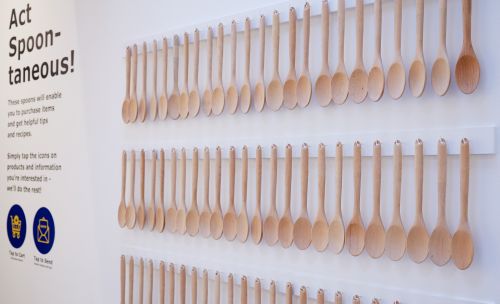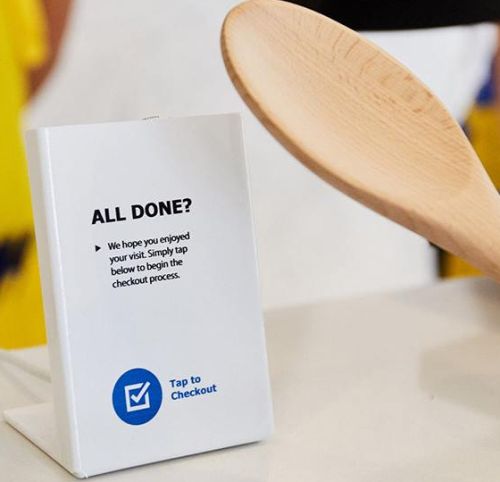Jul 11, 2016IKEA Canada has completed a two-week trial of a solution that enabled shoppers to purchase merchandise with the tap of a spoon, thanks to radio frequency identification technology. The system, deployed in a pop-up store in late May 2016, freed shoppers from having to push carts or carry baskets around the store. Instead, they simply carried a wooden spoon with a built-in RFID tag, and made their purchases by tapping the spoon against shelf readers.
The temporary store's marketing goal was to take the routine out of food and houseware shopping, and to encourage consumers to think beyond their usual products and buying habits. To achieve that goal, the store, which focused on two of IKEA's product lines (food and tableware), broke the conventional rules about how food is prepared and served, by offering unique growing, preparing and serving ideas for fresh food, along with products that included jams, seeds, pottery, glasses and other kitchenware.

"We wanted to create an experience to help support our global theme: 'It Starts With the Food,'" says Stephanie Kerr, IKEA's corporate press officer. "We thought a pop-up store would be an impactful way to bring this theme to life with consumers."
Each room within the pop-up store was designed to challenge consumers to re-think food conventions, break from traditions and try new things. For example, the company didn't want shoppers to have to use a clunky basket or shopping cart. That's where RFID technology came in.
"We wanted to make this pop-up experience different from a typical store experience," Kerr explains. "Using RFID technology allowed consumers to explore and shop in a whole new way, which made the experience more interactive."
During the two weeks in late May in which the store was open, buyers used a passive, low-frequency (LF) RFID-enabled wooden spoon to create a virtual shopping cart. Instead of taking products off a shelf and carrying them to the checkout counter, customers could simply collect a digital shopping list of all items they wanted to buy, and then make that purchase, all with the use of the wooden spoon.
Products—approximately 50 different stock-keeping units (SKUs)—were stored in a back room, while the shelves displayed a single display item for each SKU, along with a sign printed with content regarding those items, for use by shoppers.
Upon arriving at the store, a shopper encountered a wall of wooden spoons and signage, inviting her to take one. Each spoon came with a 125 KHz LF RFID tag attached to it. The tag had a unique ID number encoded on it, but the ID was not linked in any way to that specific shopper.

The customer then brought her spoon with her as she browsed through multiple rooms within the pop-up store. At every item's display area, each product came with a small sign that had a built-in LF RFID reader. The shopper was directed to place her spoon directly next to the sign if she wished to select that item for her virtual shopping cart. Each time she tapped the spoon near the reader, a small blue LED light illuminated to indicate that the spoon's ID had been interrogated. The reader then forwarded that information to the software onsite, thereby creating a link between the product and that shopper's spoon.
Workers at the store could then prepare the order according to the items being selected. When the customer was finished shopping, she proceeded to one of four checkout shelf sensors at the front of the store, each of which came with another LF RFID reader. She again tapped her wooden spoon near the device, and a touchscreen presented her with a list of the products she was purchasing. Once she approved that list, she pressed a prompt on the screen and the order was then billed to her credit or debit card. In the meantime, the staff could collect all of the items she had purchased and provide those to her.
SDImktg developed the entire solution, working with multiple hardware suppliers for tags and readers and creating the real-time back-end inventory-management system, as well as point-of-sale-based management software.
One technical challenge that the company faced, Kerr says, involved ensuring that the readers would work effectively in very close proximity to each other (often 6 inches or less). Due to this close proximity, the company opted to use LF technology as opposed to high-frequency (HF) or ultrahigh-frequency (UHF). In addition, a time-delay module in the software ensured that if several spoons' tags were tapped against readers simultaneously, all of the data would be accurately collected.
During the store's two-week tenure in Toronto, more than 200 spoons were available for consumers. Shoppers left them at the store as they exited, and they could then be reused.
The store also utilized the collected data to view what was being purchased as soon as shopper made a selection at each shelf. Workers could then ensure that inventory was properly stocked, as well as place replenishment orders to ensure that nothing went out of stock. "This allowed us to have a robust, real-time way of tracking our inventory," Kerr says, "to ensure we could re-order poplar items in a timely manner."
"Customers thought this was a fun way to shop and make the experience so much more engaging," Kerr reports, "not like a typical pop-up store." She adds that "consumers loved 'tapping' for their purchases, and were excited to see their virtual shopping list when they were checking out."
Based on the pilot's results, IKEA is now considering future ways in which it could use RFID or other technologies to continue engaging with customers. The retailer is not yet offering specifics regarding its next experiment, however.

